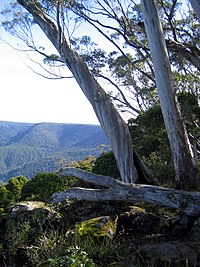Barrington Tops National Park
|
Barrington Tops National Park New South Wales |
|
|---|---|
|
IUCN category Ib (wilderness area)
|
|

The view from Captain Thunderbolt's lookout over Barrington Tops
|
|
| Nearest town or city | Gloucester |
| Coordinates | 32°3′10″S 151°29′37″E / 32.05278°S 151.49361°ECoordinates: 32°3′10″S 151°29′37″E / 32.05278°S 151.49361°E |
| Established | 3 December 1969 |
| Area | 765.12 km2 (295.4 sq mi) |
| Managing authorities | NSW National Parks & Wildlife Service |
| Website | Barrington Tops National Park |
| See also | Protected areas of New South Wales |
The Barrington Tops National Park is a protected national park located in the Hunter Valley, approximately 200 kilometres (120 mi) north of Sydney in New South Wales, Australia. Gazetted in 1969, the 76,512-hectare (189,070-acre) park is situated between Scone, Singleton, Dungog, Gloucester and East Gresford.
The park is part of the Barrington Tops group World Heritage Site Gondwana Rainforests of Australia inscribed in 1986 and added to the Australian National Heritage List in 2007. It is also part of the Barrington Tops and Gloucester Tops Important Bird Area.
Barrington Tops is part of the Mount Royal Range, a spur of the Great Dividing Range. Barrington Tops is a plateau between two of the large peaks in the range, The park is believed to be an extinct volcano and the mountain ranges are made up of a mixture of sedimentary rocks with a granite top. Erosion has weathered the granite and rounded granite boulders can be seen in some areas of the park. Estimates put the age of the rock at 300 to 400 million years, well before Australia separated from Gondwana.
The climate varies from temperate on the lower altitudes to subalpine at highest elevations. A record low of −17 °C (1 °F) has been registered at 1,500 m (4,900 ft) above mean sea level. Rainfalls fluctuate between 750 millimetres (30 in) in the northwest to more than 2,000 mm (79 in) in the southeast.
...
Wikipedia

